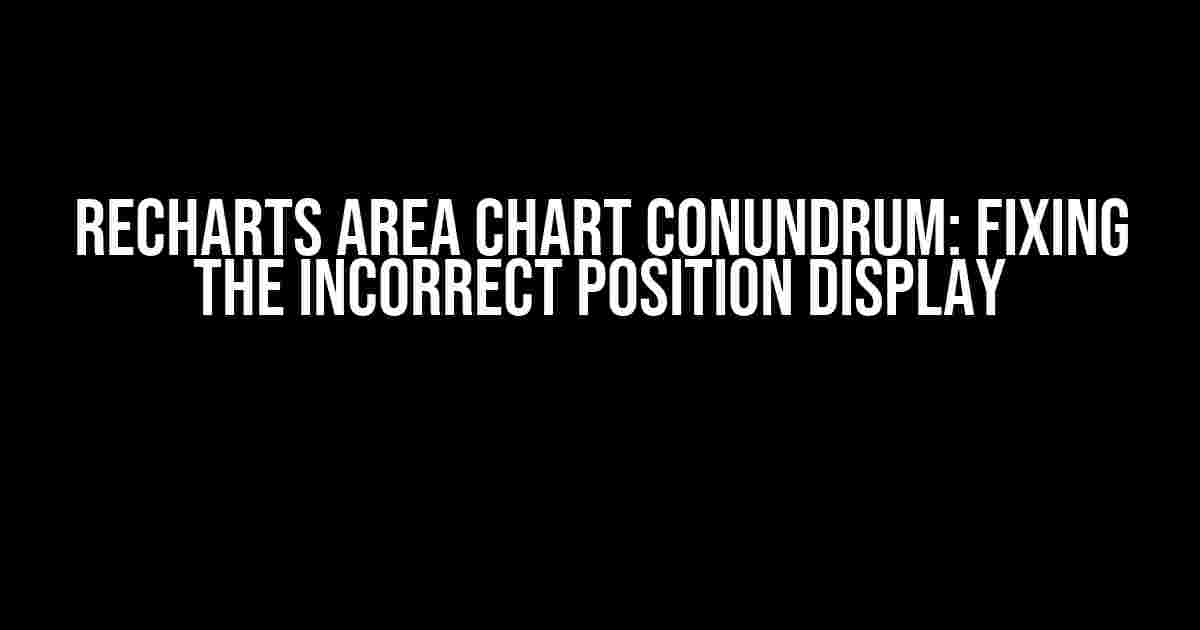Are you tired of wrestling with Recharts Area charts that insist on displaying in the wrong position? Don’t worry, you’re not alone! In this article, we’ll dive into the common reasons behind this issue and provide step-by-step solutions to get your charts back in the correct position. Buckle up and let’s get started!
The Problem: Recharts Area Chart is Displaying in the Incorrect Position
Before we dive into the solutions, let’s first understand why this issue occurs. Recharts Area charts are a fantastic way to visualize complex data, but sometimes they can be finicky. Here are some common reasons why your Recharts Area chart might be displaying in the wrong position:
- Incorrect Data Formatting: If your data is not formatted correctly, Recharts might get confused and display the chart in an unexpected position.
- Insufficient Container Dimensions: If the container element doesn’t have sufficient dimensions, the chart might not display correctly, leading to incorrect positioning.
- Overlapping Elements: When other HTML elements overlap with the chart container, it can cause the chart to display in the wrong position.
- Missing or Incorrect Chart Configuration: Failing to configure the chart correctly or providing incorrect settings can lead to positioning issues.
Solution 1: Verify Data Formatting
The first step in troubleshooting the incorrect position issue is to verify that your data is formatted correctly. Recharts Area charts expect data to be in a specific format, so let’s take a look at an example:
import { AreaChart, Area, XAxis, YAxis, CartesianGrid, Tooltip } from 'recharts';
const data = [
{ name: 'January', uv: 400, pv: 2400 },
{ name: 'February', uv: 300, pv: 1398 },
{ name: 'March', uv: 200, pv: 9800 },
{ name: 'April', uv: 278, pv: 3908 },
{ name: 'May', uv: 189, pv: 4800 },
];
const SimpleAreaChart = () => (
<AreaChart width={400} height={300} data={data}>
<Area type="monotone" dataKey="uv" stroke="#8884d8" fill="#8884d8" />
<XAxis dataKey="name" />
<YAxis />
<CartesianGrid stroke="#ccc" strokeDasharray="5 5" />
<Tooltip />
</AreaChart>
);
In this example, the data is formatted as an array of objects, where each object represents a single data point. The `name` property is used for the x-axis, while the `uv` property is used for the area chart series. Make sure your data is formatted similarly.
Solution 2: Ensure Sufficient Container Dimensions
If your container element doesn’t have sufficient dimensions, the chart might not display correctly. To fix this, ensure that the container element has a defined width and height:
<div style={{ width: 400, height: 300 }}>
<SimpleAreaChart />
</div>
In this example, we’ve added an inline style to the container element, setting the width and height to 400 and 300 pixels, respectively. You can adjust these values according to your needs.
Solution 3: Remove Overlapping Elements
Sometimes, other HTML elements might be overlapping with the chart container, causing the chart to display in the wrong position. To fix this, inspect your HTML code and remove any overlapping elements:
For example, if you have an overlaying div with an absolute position, try removing it or adjusting its z-index:
<div style={{ position: 'absolute', zIndex: -1 }}>...</div>
By removing or adjusting the overlapping element, you should be able to see the chart in its correct position.
Solution 4: Verify Chart Configuration
The final step in troubleshooting the incorrect position issue is to verify that your chart configuration is correct. Here are some common chart configuration options that might affect positioning:
| Option | Description |
|---|---|
margin |
Sets the margin around the chart. If set incorrectly, the chart might display in the wrong position. |
align |
Sets the alignment of the chart within its container. Make sure it’s set correctly to avoid positioning issues. |
legend |
Configures the legend. If the legend is not configured correctly, it might overlap with the chart, causing positioning issues. |
Here’s an example of correct chart configuration:
const SimpleAreaChart = () => (
<AreaChart
width={400}
height={300}
margin={{ top: 20, right: 20, bottom: 20, left: 20 }}
align="center"
data={data}
>
<Area type="monotone" dataKey="uv" stroke="#8884d8" fill="#8884d8" />
<XAxis dataKey="name" />
<YAxis />
<CartesianGrid stroke="#ccc" strokeDasharray="5 5" />
<Tooltip />
</AreaChart>
);
In this example, we’ve set the chart’s margin to 20 pixels on all sides, aligned the chart to the center, and configured the legend correctly.
Conclusion
With these solutions, you should be able to fix the incorrect position issue with your Recharts Area chart. Remember to:
- Verify data formatting
- Ensure sufficient container dimensions
- Remove overlapping elements
- Verify chart configuration
By following these steps, you’ll be able to get your Recharts Area chart displaying in the correct position in no time. Happy charting!
Additional Tips and Tricks
Here are some additional tips and tricks to help you troubleshoot and optimize your Recharts Area chart:
- Use the Recharts Debug Tool: The Recharts debug tool can help you identify issues with your chart configuration and data.
- Check Your Data Types: Ensure that your data is of the correct type. Recharts expects numerical data for the y-axis and categorical data for the x-axis.
- Use a Responsive Chart Container: Use a responsive chart container to ensure that your chart adapts to different screen sizes and devices.
By following these tips and tricks, you’ll be well on your way to creating stunning and accurate Recharts Area charts that display in the correct position.
Frequently Asked Question
Having trouble with Recharts Area chart displaying in the incorrect position? We’ve got you covered! Below, we’ve gathered the most frequently asked questions to help you troubleshoot and fix the issue.
Why is my Recharts Area chart not displaying in the correct position?
One of the most common reasons for this issue is incorrect or missing configuration options. Double-check your chart’s `width`, `height`, and `margin` properties to ensure they’re set correctly. Also, make sure you’re using the latest version of Recharts.
How do I adjust the padding and margins of my Recharts Area chart?
You can adjust the padding and margins by setting the `margin` property in your chart’s configuration. For example, `margin={{ top: 20, right: 20, bottom: 30, left: 40 }}`. You can also use the `padding` property to add extra space between the chart and its container.
What if my Recharts Area chart is still not displaying correctly after adjusting the configuration?
If you’ve checked and adjusted the configuration options, the next step is to inspect the chart’s DOM elements. Use your browser’s developer tools to check if there are any CSS styles or layout issues affecting the chart’s position. You can also try setting `overflow: visible` on the chart’s container to ensure it’s not being clipped.
Can I use CSS to customize the position of my Recharts Area chart?
Yes, you can use CSS to customize the position of your Recharts Area chart. You can target the chart’s container element and apply styles such as `position`, `top`, `left`, `transform`, or `flexbox` to adjust its layout. Just be sure to avoid applying styles that might conflict with Recharts’ built-in layout management.
Are there any other common pitfalls to watch out for when using Recharts Area chart?
Yes, be cautious when using `svg` elements inside the chart, as they can affect the chart’s layout. Also, ensure that your dataset is properly formatted and that you’re not exceeding the maximum number of data points. Finally, keep an eye out for version compatibility issues, as Recharts is actively maintained and new features might require updates to your code.



![Trouble with ggplot2 in Current Version of R (0.4.2+764) [duplicate] Trouble with ggplot2 in Current Version of R (0.4.2+764) [duplicate]](https://jarleath.hkhazo.biz.id/wp-content/uploads/sites/373/2024/07/trouble-with-ggplot2-in-current-version-of-r-0-4-2764-duplicate-with-text-300x300.jpg)